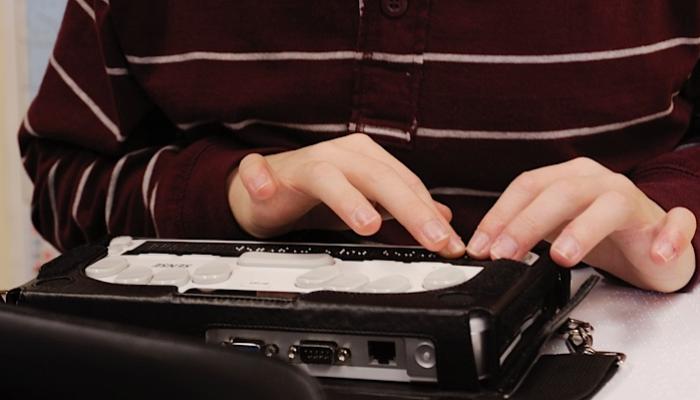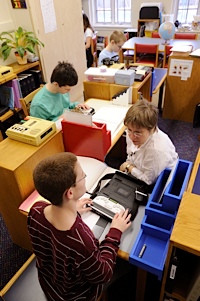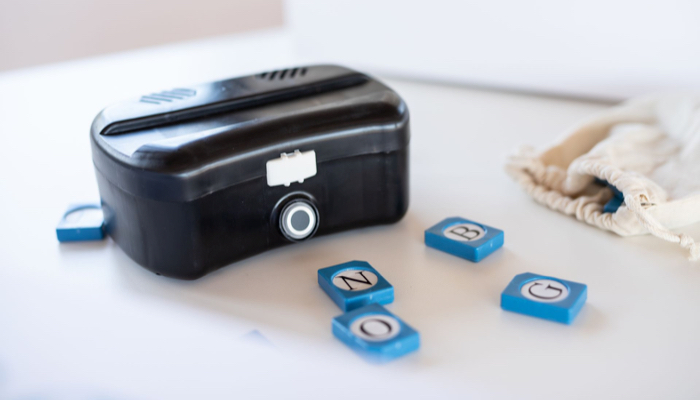APH Quota Funds: How to Access Free Educational Materials for Blind & Deafblind Students

Have you heard of APH Quota Funds? It’s something I’ve heard mentioned in IEP meetings, but I’ve never understood how it really works or who is eligible for this program. I decided to do a little research and this is what I found….
What are Quota Funds?
APH Quota Funds are based on the federal “Act to Promote the Education of the Blind.” This act, passed by congress in 1879, recognizes that students who are blind or deafblind, with or without additional disabilities, require special materials to access school curriculum.
Rather than telling school districts or individual families that it’s their responsibility to purchase these items on their own, congress sets aside funds every year specifically so that schools can buy blind students the materials they need. These materials vary from braillers or brailled text books to items that facilitate self-help or sensory development, but only include items that can be purchased through APH. These funds really cover a variety of items that your child would need in school, so it’s important to understand how to access them.
Who Distributes Quota Funds?
Each school district or education department in the US has what is called an Ex Officio Trustee who decides how quota funds are spent in their area. They are responsible for approving and processing all orders as well as conducting an annual census of eligible students in their area (which is actually really important because this number informs congress as to how much money to put into the account for each school district every year).
You can find a list of Ex Officio Trustees on the APH website ordered by state. Just look up your state and find your Ex Officio Trustee. If your child is not on the Ex Officio Trustee’s registry, you can ask them to add your child and develop the best way to serve your child in the program. If there is an underserved population in your district, it is always possible that an additional Ex Officio Trustee would be added to your area, but most likely you will work with whoever is listed in the directory.

Who is Eligible for Quota Funds?
The law is actually very inclusive, including all students in a school district, as well as infants in Early Intervention programs, homeschoolers and students in parochial and private schools. As long as the student’s educational program meets the guidelines and/or procedures in effect within each individual state and the student has a written education plan (an IFSP or an IEP), they’re in the program.
What Can You Buy with Quota Funds?
Quota funds can only be used to purchase products APH sells. If you look on the APH shopping site or in their catalogs, the items NOT available for purchase with Quota funds are clearly marked. Most of the things they sell are Quota eligible, but there are a few things that they sell from other vendors. For a product to be eligible to be sold for Quota funds, it can’t be commercially available anywhere else, or, if it is, it has to be adapted in some way to make it unique to APH.
By the way, APH is a partner in the development of the Perkins SMART Brailler which is available for purchase as a federal quota product for US customers through their website. APH sells the SMART Brailler with the included Building on Patterns Kindergarten exercises app already installed. If you are outside the US, the SMART Brailler is available direct through Perkins.
How Much Money Do You Get with Quota Funds?
This depends on what the federal budget has allocated for that fiscal year. In the recent past it’s been over $300 per student.
When you hear that something is “available on quota,” what this really mean is that is has been approved for purchase with federal quota funds, not that it can necessarily be purchased solely with the per capita amount of one student.
Many of APH’s products exceed the per capita amount for each child, so they strongly encourage states to operate within the framework of an instructional materials center. In that model, products are held by the materials center until they are needed by a student, and are then loaned or “checked out” to that student. It might be for a year, it might be for several years, it just depends on the needs of the students. In that manner, states are able to better leverage the funds they receive and provide more products for more students.
Will every school district be able to purchase every single thing every teacher or student wants? Probably not. But by warehousing the materials and distributing them as they are needed, the school district can meet a lot of needs.
Can You Use Materials at Home?
If these items are purchased through your school district with federal money, do they belong to you or to the state? Can you use them at home?
Technically the items would belong to your school district, but their use would depend on your child’s needs. Items purchased for infants in Early Intervention or students who are homeschooled would most likely need to be used at home, but where a product “lives” is determined by the Ex Officio Trustee and depends on the student, their needs and what it is they are purchasing.
Ultimately, the program would like to see products used in such a way that the most students can benefit from them. Sometimes that means a long-term loan, sometimes it means that product stays with that child and sometimes it means a product may be shared by several students in a classroom.
If your child is using material that is essential to their day-to-day work in class, it would make sense that the material move with them as they advance from one grade to another, but again this is totally dependent on your child, their needs and the material they are using. If your child moves from one school district to another (or from one state to another), the material may not move with them. But maybe you can look at it as an opportunity to “upgrade” and get something newer! All of this would of course be determined by your Ex Officio Trustee.
Who Should You Contact?
If you want to purchase items for your child through the APH Quota Fund, you should probably begin by talking to your child’s teacher or your school district’s Special Education Director. If they are unfamiliar with the program, use the APH directory and contact your Ex Officio Trustee. Because this is a program administered through federal funds, you as a parent don’t register your child or file paperwork requesting materials; the process needs to go through your school district and the Ex Officio Trustee. Which is actually kind of nice, if you think about it. For once you won’t be the one responsible to fill out forms!
If you need more information about how this program works, you can contact APH directly at info@aph.org or contact Janie Blome, Director of Field Services, at 502-899-2367 or jblome@aph.org.
Related Posts

IEPs
What Should I Bring to My Child’s First IEP Meeting?
Prepare for your child's first IEP meeting with confidence! Discover exactly what documents to bring, including educational records, medical info, and questions to ask.

Visual Impairment
The Gift of Understanding: How a Young Child Helps His Blind Father Navigate Life
When a parent is blind, it’s natural for people to wonder how their sighted child will adapt. Will they struggle to understand their parent’s needs? Will they feel burdened by...

Braille and Literacy
Making Braille Fun: Introducing Handi Exceller’s Innovative Learning Tools for Blind Students
Handi Exceller was born from a simple idea: learning braille should be both fun and accessible. The company creates interactive and gamified ways to teach braille.